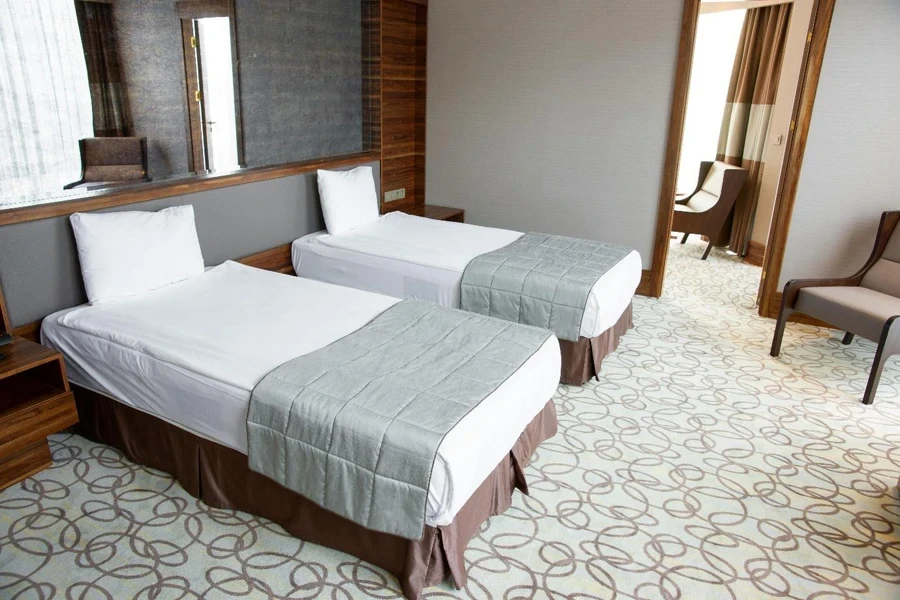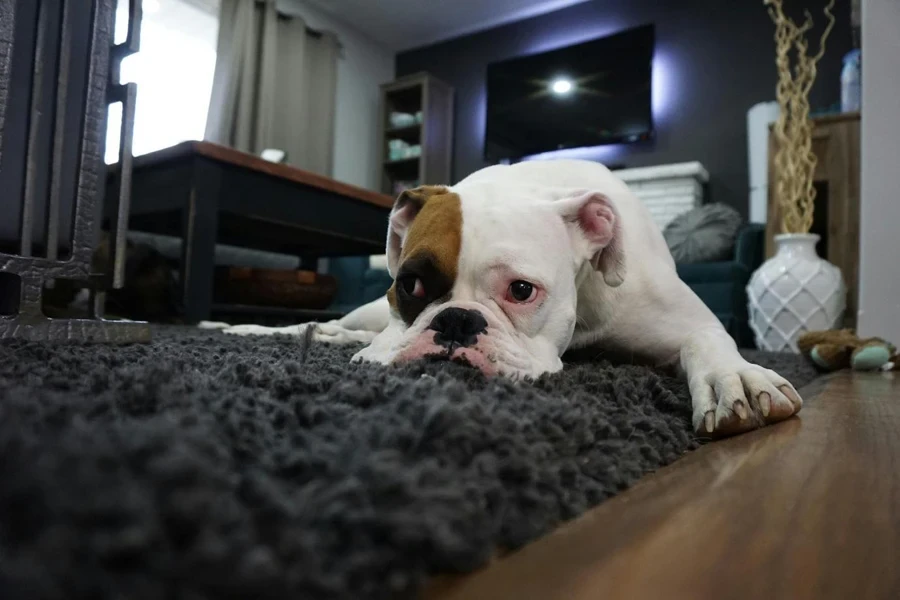Table of Contents
● Introduction
● Market overview
● Different types and their features
● Things to consider when selecting products
● Conclusion
Introduction

Carpets play an important role in function and style by providing a mix of charm and coziness in various business and home settings. The rug industry is constantly changing due to improvements in materials, eco-friendly movements, and an increasing desire for multiple choices, from sturdy nylon to opulent wool. Each type of rug offers distinct advantages and factors to take into account. Selecting the perfect carpet requires balancing durability, upkeep, and eco-friendliness to fulfill project requirements. Understanding these elements is crucial when making informed buying choices in the current bustling market environment.
Market overview

Market size and growth
The worldwide carpet industry had a $72.39 billion worth in 2023. It is projected to rise to $110.82 billion by 2033 with an average annual growth rate of 4.35%, as The Brainy Insights publication reported. This increase is fueled by the rising incomes among the middle-income group, resulting in more expenditure on home decorations and interior upgrades. The market’s growth is also backed by improvements made to carpet production techniques and the increasing prevalence of online shopping and e-commerce websites that have made carpets available to a large group of buyers.
Key market segments
The carpet market is divided based on the type of material used, the price range of the target consumer, and how they are sold. Nylon is the top material choice, with around 45.18% market share in 2023, due to its strength and ability to handle heavy use. As for pricing categories, the economy segment holds the market share at 72.41%, attracting those who are mindful of their budget and appealing to a wide range of consumers. The housing sector stands out as the largest consumer group in the market at 54.72%, mainly due to homeowners opting for flooring solutions that offer both comfort and aesthetic appeal.
Different types and Their features

Fiber types
Nylon 6,6
Nylon 6,6 is recognized for its superior strength and resilience. Its molecular structure provides exceptional tensile strength and abrasion resistance, making it a preferred choice for high-traffic areas such as commercial spaces. The solution-dyed process used in nylon carpets ensures deep color penetration, enhancing colorfastness and resistance to fading. This makes nylon carpets ideal for environments exposed to significant wear and direct sunlight.
Polyester (PET)
Polyester is known for being environmentally friendly when made from polyethylene terephthalate (PET), as it frequently includes recycled components such as bottles in its composition. They are resistant to stains due to their closed-cell structure. However, polyester is less durable than nylon, making it susceptible to flattening when bearing weight. This quality makes it better suited for spaces with foot traffic where comfort and looks take precedence over longevity.
Wool
Known for its luxurious texture and superb insulation abilities, wool is a sought-after fiber, due to its elasticity provided by its natural crimp that resists crushing well. Moreover, wool boasts natural flame-retardant properties and excels at trapping heat and muffling sound. However, it comes at a high cost and demands frequent upkeep, especially in settings prone to moisture and stains.
Olefin (polypropylene)
Polypropylene or olefin stands out for its ability to resist moisture and stains while also being resistant to chemicals. These are the characteristics that make it a popular option for carpets and spaces vulnerable to spills and humidity, like basements. However, its lower melting point and vulnerability to friction mean that it might not be the right choice for high-temperature settings or areas where furniture movement is frequent.
Triexta (PTT)
Triexto is crafted using elements sourced from renewable resources, such as corn. These elements combine comfort and strength in their makeup, with a semi-crystalline structure resembling nylon’s Restylane with a touch as soft as polyester. The compact fiber construction of Triexto boosts its durability; however, cleaning could be tricky due to its tightly packed fibers.
Pile types
Cut pile
Cut pile carpets have a tufted surface due to the loops of yarn being cut to give a plush feel to them. The durability of pile carpets depends significantly on the density of the tufts. Higher densities result in better resistance to crushing. This is why cut pile carpets are commonly chosen for homes where softness is valued, even though they might display footprints and vacuum marks.
Loop pile
Loop pile carpets keep the yarn loops intact, making them strong and long-lasting. The even height of the loops in level loop carpets provides a resilient surface ideal for busy places such as offices and hallways. Multi-level loop carpets have varying loop heights that create textured designs that add visual appeal and are durable.
Cut-and-loop pile
Cut and loop pile carpets mix looped and cut threads to produce intricate designs and textures, improving visual charm while effectively concealing dirt and signs of usage. The combination of the loop piles’ durability and the pile’s softness renders this carpet style versatile for use in various settings, be it residential or commercial.
Carpet grades and backing
Carpet grades
Carpet quality levels are decided based on aspects such as the type of fiber used and the weight and density of the face material in the carpet itself, which is a measure of its excellence. High-quality carpets, usually featuring a face weight of over 40 ounces, provide top-notch durability and resilience, perfect for luxurious surroundings. Density refers to the number of fibers per square inch, where higher densities enhance wear resistance and comfort.
Primary and secondary backing
The support underneath a carpet is essential for how it performs. The primary backing is the layer where the fibers are attached and is typically crafted from nonwoven polypropylene material. The secondary support provides stability and protection against moisture with options like polyurethane or latex. It adds stability, moisture resistance, and cushion for comfort. This two-layer setup improves the carpet’s shape retention and durability by preventing separation over time. This makes it last longer in homes and businesses alike.
Things to consider when selecting products

High-traffic durability
When picking out carpets for places with lots of people moving around all the time, like hallways and offices, it’s super important to pay attention to what they’re made of and how they’re put together. This helps to ensure they last a long time without getting worn out. One popular choice for these areas is Nylon 6,6, known for being tough. This makes it a top pick for traffic spots like hallways and busy offices because it can handle all the wear and tear that comes with continuous foot traffic without looking worn down. Another good option is loop pile carpets, the level loop kind, because their packed fibers make them resistant to flattening or matting down easily, giving them extra durability over time. The thickness of these rugs is often gauged by the number of tufts per inch. It significantly affects how well they hold up over time in places with heavy foot traffic.
Comfort in low-traffic areas
Plush and Saxony cut pile carpets are the go-to choice for a cozy and luxurious feel under your feet in areas like bedrooms or fancy living spaces that focus on comfort rather than lasting. These carpets are usually made from wool or dense polyester, giving them a smooth texture that adds comfort. Their thicker face weight also adds to their plushness, with premium selections having face weights of over 40 ounces per square yard. These rugs provide comfort but are susceptible to displaying footprints and vacuum tracks; therefore, they may not be ideal for high-traffic areas. They are perfect for creating a cozy and welcoming ambiance in spaces requiring a soft surface.
Stain resistance and cleaning
To keep carpets in areas prone to dirt and spills, it is essential to use materials that are resistant to stains and easy to clean up messes. Having a structure made of Triexta fibers contributes significantly to preventing absorption due to their closed-cell nature, resulting in stain resistance capabilities that are highly effective at repelling stains. Furthermore, hydrophobic properties further boost this quality by ensuring liquids cannot seep into the carpet’s surface. Carpets with solution-dyed fibers, like nylons and polyesters, retain color and resist fading. This helps ensure that stains can be easily removed without causing any harm to the carpet’s look. Moreover, regular cleaning and upkeep become easier with low-pile loop carpets as they are less prone to trapping dirt and dust. As a result, the need for cleaning is reduced in terms of frequency and intensity.
Environmental sustainability
Picking out more environmentally friendly carpets has become a priority for people who care about the planet’s well-being. Eco-conscious consumers often opt for recycled PET polyester carpets made from bottles because of their eco-manufacturing process and contribution to waste reduction. These polyester carpets help the environment and provide excellent stain resistance and color durability. Another sustainable choice is wool carpets made from fibers that decompose easily and from sheep farms that follow ethical practices. Natural wool carpets have a built-in flame resistance feature and don’t need the treatments synthetic fibers often require to be fire retardant. This helps minimize their impact on the environment.
Longevity and cost considerations
In assessing how long a carpet lasts and whether it’s worth the cost, consider both the kind of fiber used and the quality of the rug over time. Top-notch carpets with a denser weave and heavier face weight tend to be more durable, making them a smart choice in the long run despite being pricier upfront. Nylon and Triexta carpets are recognized for their longevity, often lasting over 15 years, making them perfect in properly cared-for homes. The upfront cost is higher when you compare it to alternatives such as olefin, which might need replacing more often because it’s not as durable or resistant to wear and tear. It’s crucial to factor in all costs, including maintenance and possible replacements, when deciding what makes a good choice.
Conclusion

Choosing the right carpet involves grasping the market trends and material characteristics that suit your needs perfectly. It’s crucial to consider aspects like longevity and comfort, along with how easy it’s to maintain and its impact, so businesses can pick a carpet that looks good, lasts long, and adds value in the long run. Taking a stance on selecting ideal carpets can elevate the usefulness and charm of any business or living area by effectively meeting both demands and sustainability objectives.



